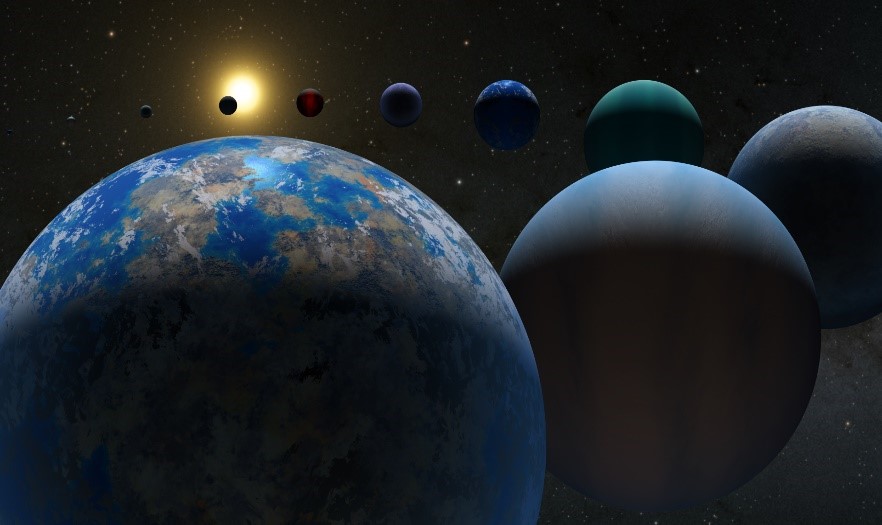The Exoplanet Revolution: Searching for Other Earths
Look up at the sky on a clear night, somewhere far from the lights of the city, and you will see more stars than you can count. Our own star, the sun, is one of hundreds of billions of stars bound together by gravity in a galaxy — a term that comes from the Greek word for milky, since the night sky is so filled with white starlight that it can look like it is splashed with milk. Our Milky Way galaxy is, in turn, just one of hundreds of billions of galaxies in the universe.

Figure 1. The Exoplanet Revolution: Searching for Other Earths
The Exoplanet Revolution: Searching for Other Earths is shown in Figure 1. Our sun has eight planets — Mercury, Venus, Earth, Mars, Jupiter, Saturn, Uranus, and Neptune — as well as an asteroid belt; a belt of small icy bodies beyond Neptune (the Kuiper belt); several dwarf planets like Pluto; and numerous planetary moons and other objects. Knowing this, it is only natural to wonder when you look up at the night sky how many of those other stars have planets like ours orbiting them. And are any of those other Earths home to intelligent life forms — perhaps looking out at the stars in their sky, back at our sun, wondering the same thing?
A few decades ago, astronomers began the systematic search for planets around other stars — what are now called “exoplanets.” This fall marks the twentieth anniversary of the announcement of the discovery of 51 Peg b, the first planet confirmed to be orbiting a sun-like star. Since then, astronomers have discovered more than five thousand other confirmed or likely exoplanets.[1]
We embark on a journey that stretches the boundaries of our imagination: the quest to discover and understand exoplanets. With technological advancements and innovative techniques, astronomers are revolutionizing our understanding of planetary systems beyond our own, offering tantalizing glimpses into the possibility of finding other Earth-like worlds.
Beyond the Visible: The Electromagnetic Spectrum
- Introduce the electromagnetic spectrum, from radio waves to gamma rays.
- Explain how different wavelengths provide unique information about celestial objects and processes.
- Highlight the limitations of visible light astronomy and the need for multi-wavelength observations.
Defining Exoplanets: Worlds Beyond Our Solar System
- Introduce the concept of exoplanets, planets that orbit stars other than the Sun.
- Discuss the significance of exoplanet discoveries in reshaping our understanding of the cosmos and the potential for habitable worlds.
Transit and Radial Velocity Methods: Detecting Exoplanets
- Explain the transit method, where a planet passing in front of its star causes a temporary dimming of light.
- Explore the radial velocity method, which detects a star's wobble caused by the gravitational pull of an orbiting planet.
- Highlight how these techniques have led to the discovery of thousands of exoplanets.
Kepler and TESS Missions: Unveiling Exoplanet Diversity
- Showcase the Kepler Space Telescope's role in revolutionizing exoplanet detection through the transit method.
- Introduce the Transiting Exoplanet Survey Satellite (TESS) and its mission to discover exoplanets around nearby stars.
- Discuss the diverse range of exoplanets found, including hot Jupiters, super-Earths, and potentially habitable exoplanets.
Characterizing Exoplanets: Probing Atmospheres and Habitability
- Explore the concept of exoplanet characterization, including studying their atmospheres for signs of life.
- Highlight the role of the James Webb Space Telescope (JWST) in analyzing exoplanet atmospheres and identifying potential biomarkers.
- Discuss the challenges and promise of identifying habitable exoplanets and potential targets for future exploration.
The Exoplanet Zoo: Unveiling Surprises and Mysteries
- Reflect on the unexpected diversity of exoplanet systems, including hot Jupiters and planets in binary star systems.
- Discuss the mystery of "hot Earths" and the ongoing debate about their formation and evolution.
- Explore the potential for discovering exomoons and the implications for habitability.
Conclusion: The exoplanet revolution is reshaping our understanding of the universe and our place within it. As we uncover more exoplanets and gain insights into their characteristics, we inch closer to answering the age-old question: Are we alone in the cosmos? The search for other Earth-like worlds not only fuels our scientific curiosity but also ignites our imagination about the potential for life beyond our solar system. Stay tuned for the next installment in our series, where we'll continue our exploration of the frontiers of astronomical discovery.
References:
- https://www.thenewatlantis.com/publications/searching-for-other-earths
Cite this article:
Gokula Nandhini K (2023), The Future of Astronomy: Advancements and Discoveries, AnaTechmaz, pp.3





